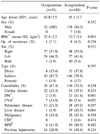Abstract
Purpose
We are to describe the clinical characteristics and treatment outcomes in patients aged between 80 and 89 years who underwent inguinal hernia repair under local anesthesia.
Methods
We retrospectively reviewed the medical records of patients aged between 20 and 89 years who underwent tension free hernia repair under local anesthesia by a single surgeon between June 2001 and January 2009 and compared clinical characteristics and outcomes between octogenarians who were the eldest and sexagenarians whose incidence was the highest.
Results
Of the 514 patients, the number of octogenarians was 52 (8.6%) and sexagenarians were 225 (35.0%). Body mass index (BMI) was 22.5 kg/m2 in octogenarians and 23.7 kg/m2 in sexagenarians (P=0.003). Underlying diseases were present in 67.3% of octogenarians and 73.5% of sexagenarians (P=0.238). The incidence of liver disease was significantly lower in the octogenarians (1.9% vs 15.7%, P=0.004). The proportion of patients who underwent local anesthesia was significantly higher among the octogenarians (94.5% vs 82.2%, P=0.014). Operative time and postoperative hospital stay had no significant difference between both groups. Postoperative complications developed in 4 (7.7%) of the octogenarians and in 18 (9.7%) of the sexagenarians. Scrotal swelling was developed most frequently and surgery-related mortality did not developed in both groups.
Figures and Tables
References
1. Namgung YI, Yoo SH, Lee ES. Inguinal herniorrhaphy under the local anesthesia in the aged patients. J Korean Surg Soc. 1990. 39:657–662.
2. Pisanu A, Montisci A, Piu S, Uccheddu A. Curative surgery for gastric cancer in the elderly: treatment decisions, surgical morbidity, mortality, prognosis and quality of life. Tumori. 2007. 93:478–484.
3. Berger DH, Dardik A, Rosenthal RA. Townsend CM, Evers BM, Beauchamp RD, Mattox KL, editors. Surgery in the elderly. Sabiston Textbook of Surgery: The Biological Basis of Modern Surgical Practice. 2008. 18th ed. Philadelphia: W.B. Saunders;371–399.
4. Kim JK, Choi KP. A clinical review of 305 cases of inguinal hernia. J Korean Surg Soc. 1988. 35:346–354.
5. Arenal JJ, Rodriguez-Vielba P, Gallo E, Tinoco C. Hernias of the abdominal wall in patients over the age of 70 years. Eur J Surg. 2002. 168:460–463.
6. Rutkow IM, Robbins AW. Demographic, classificatory, and socioeconomic aspects of hernia repair in the United States. Surg Clin North Am. 1993. 73:413–426.
7. Hair A, Paterson C, Wright D, Baxter JN, O'Dwyer PJ. What effect does the duration of an inguinal hernia have on patient symptoms? J Am Coll Surg. 2001. 193:125–129.
8. Bay-Nielsen M, Thomsen H, Andersen FH, Bendix JH, Sorensen OK, Skovgaard N, et al. Convalescence after inguinal herniorrhaphy. Br J Surg. 2004. 91:362–367.
9. Fitzgibbons RJ, Jonasson O, Gibbs J, Dunlop DD, Henderson W, Reda D, et al. The development of a clinical trial to determine if watchful waiting is an acceptable alternative to routine herniorrhaphy for patients with minimal or no hernia symptoms. J Am Coll Surg. 2003. 196:737–742.
10. Neumayer L, Giobbie-Hurder A, Jonasson O, Fitzgibbons R Jr, Dunlop D, Gibbs J, et al. Open mesh versus laparoscopic mesh repair of inguinal hernia. N Engl J Med. 2004. 350:1819–1827.
11. O'Dwyer PJ, Norrie J, Alani A, Walker A, Duffy F, Horgan P. Observation or operation for patients with an asymptomatic inguinal hernia: a randomized clinical trial. Ann Surg. 2006. 244:167–173.
12. Kemler MA, Oostvogel HJ. Femoral hernia: is a conservative policy justified? Eur J Surg. 1997. 163:187–190.
13. Jung SW, Heo TG, Lee JM, Choi PW, Park JH, Lee MS, et al. Clinical analysis of 473 cases of inguinal hernia in adult patients. J Korean Surg Soc. 2008. 75:109–115.
14. Srivastava U, Kumar A, Saxena S, Neeraj , Sehgal DR. Comparison of local, spinal and general anaesthesia for inguinal hernia repair. J Anesthesiol Clin Pharmacol. 2007. 23:151–154.
15. Ozgun H, Kurt MN, Kurt I, Cevikel MH. Comparison of local, spinal, and general anaesthesia for inguinal herniorrhaphy. Eur J Surg. 2002. 168:455–459.
16. Karatassas A, Morris RG, Walsh D, Hung P, Slavotinek AH. Evaluation of the safety of inguinal hernia repair in the elderly using lignocaine infiltration anaesthesia. Aust N Z J Surg. 1993. 63:266–269.
17. Nienhuijs SW, Remijn EE, Rosman C. Hernia repair in elderly patients under unmonitored local anaesthesia is feasible. Hernia. 2005. 9:218–222.
18. Young DV. Comparison of local, spinal, and general anesthesia for inguinal herniorrhaphy. Am J Surg. 1987. 153:560–563.
19. Subramaniam P, Leslie J, Gourlay C, Clezy JK. Inguinal hernia repair: a comparison between local and general anaesthesia. Aust N Z J Surg. 1998. 68:799–800.
20. Sanjay P, Woodward A. Inguinal hernia repair: local or general anaesthesia? Ann R Coll Surg Engl. 2007. 89:497–503.
21. Gultekin FA, Kurukahvecioglu O, Karamercan A, Ege B, Ersoy E, Tatlicioglu E. A prospective comparison of local and spinal anesthesia for inguinal hernia repair. Hernia. 2007. 11:153–156.
22. Baschieri G, Cuneo S, Vitale B, Simonelli A, Steinweg M, Gianetta E. 6 years of experience in inguinal and femoral hernioplasty in patients over 65 years of age. G Chir. 1997. 18:815–819.
23. Roseano M, Ressetta G, Pozzetto B, Babich F, de Manzini N. The treatment of inguinal hernia in the elderly: open technique or laparoscopic approach? Acta Biomed. 2005. 76:Suppl 1. 52–55.
24. Kulah B, Duzgun AP, Moran M, Kulacoglu IH, Ozmen MM, Coskun F. Emergency hernia repairs in elderly patients. Am J Surg. 2001. 182:455–459.
25. Alvarez Perez JA, Baldonedo RF, Bear IG, Solis JA, Alvarez P, Jorge JI. Emergency hernia repairs in elderly patients. Int Surg. 2003. 88:231–237.
26. Gianetta E, de Cian F, Cuneo S, Friedman D, Vitale B, Marinari G, et al. Hernia repair in elderly patients. Br J Surg. 1997. 84:983–985.




 PDF
PDF ePub
ePub Citation
Citation Print
Print





 XML Download
XML Download